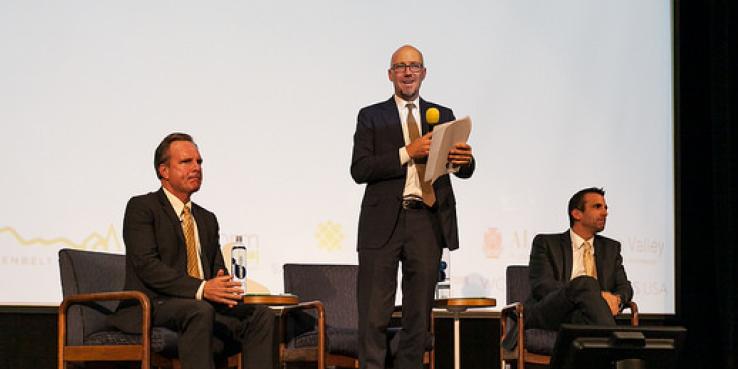San Jose is on the cusp of explosive growth, projecting to add nearly half a million people in the next 30 years. What happens during the next mayoral term will affect the city for decades to come. To help voters get to know the candidates and their positions on our issues, SPUR and six partner organizations held a debate October 9 between the two contenders vying for the seat, Santa Clara County Supervisor Dave Cortese and San Jose City Councilmember Sam Liccardo.
Hosted at San Jose State University, the debate attracted nearly 400 attendees. Questions came from the public, SPUR members and our partner organizations, the American Institute of Architects Santa Clara Valley, Greenbelt Alliance, the San Jose Downtown Association, the Silicon Valley Bicycle Coalition, TransForm and Working Partnerships USA.
Most debates between these two candidates have covered the same territory: pension reform and crime. Instead we asked about their vision for land use, transportation, economic equity and other urbanist issues. Take a look at the questions we asked, read the Silicon Valley Business Journal’s summary of the debate and listen to the audio recording (at the bottom of this post), but above all – vote on November 4!
The General Plan and Balancing Land Use Goals
Question 1: San Jose’s 2040 General Plan is the guiding land use document about how and where our city will accommodate growth over the next 30 years. It proposes to direct growth into walkable, transit-oriented urban village areas and to stop building in low-density patterns that force people to drive. As mayor, what will you do to carry this idea forward and implement it?
Question 2, from Greenbelt Alliance: San Jose's General Plan has been called a “jobs-first plan” because it prioritizes increasing the ratio of jobs to employed residents in the city. As mayor, you will likely need to balance the jobs-first priority of the plan with other important policy goals, for example providing housing for a growing Silicon Valley workforce and providing affordable housing for people who cannot afford market rate prices. As mayor, what is your approach to these competing land use goals?
Transportation
Question 3: Too many San Joseans are stuck in traffic or dependent on a transit system that doesn't serve their needs. A key part of a successful city is a high-quality public transit system that works well for people. How will you use or direct your vote on the Santa Clara Valley Transportation Authority Board of Directors to improve bus light rail service?
Question 4, from TransForm: The proposed 2016 quarter-cent transportation sales tax could go a long way to improving transit service in Santa Clara County. What kinds of goals and priorities do you feel should guide the selection of projects and programs funded by that proposed sales tax?
Question 5, from the Silicon Valley Bicycle Coalition: Under your leadership what will the City of San Jose do to achieve its bicycling goals as laid out in the General Plan (i.e., that 5 percent of trips will be by bicycle by 2020 and 15 percent of all trips by 2040)?
Architecture
Question 6, from AIA Santa Clara Valley: Do you think good architecture is important to making San Jose a great city, and can you share your thoughts on the role of architecture in improving our urban environment?
Climate Change
Question 7: The impacts of climate change are becoming well understood. Any city as large and influential as San Jose has the responsibility to be part of the solution. What do you think are the most important changes that should be made to reduce the greenhouse gasses generated in San Jose and to prepare for the impacts of climate change?
Homelessness
Question 8, from the San Jose Downtown Association:
San Jose has an increasing homeless population. What is your approach for reducing this population downtown and citywide?
Economic Equity
Question 9, from Working Partnerships, USA:
30 percent of the jobs produced in Silicon Valley don’t pay enough to live on. Even highly skilled people with college degrees are being forced to take poverty-level jobs. How have you supported government actions that pressure the private sector to raise wages and benefits, and how have you opposed actions that force people into lower paying jobs, such as outsourcing city work to private firms that offer much lower pay and inadequate benefits?
Land Use Decisions
Question 10: The Evergreen industrial area and the Coyote Valley are two big expanses of open land that came close to being developed in the past decade. Developers would like to build residential subdivisions on both, in opposition to the direction of the city’s General Plan. As mayor over potentially the next eight years, will you consider proposals to change the general plan and allow housing to be built in either Evergreen or Coyote Valley, or both?
Question 11: North San Jose has been planned as the major job center of the city, accessed by light rail and designed to be a walkable place. Imagine that a developer comes to you as mayor and says, “I have a really large employer who is willing to come to North San Jose, but I want to build in the more traditional, suburban pattern.” As mayor, what do you do?
Question 12: It’s four years from now and you're ending your first term. What do you want to say you did to move the nation's 10th largest city forward?
Read the Silicon Valley Business Journal’s coverage of the debate >>
Listen to a recording of the debate (low sound quality):
